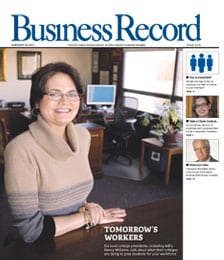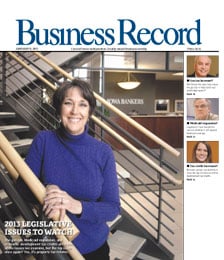A world of IT opportunities

When Dave Hoxeng graduated from college nine years ago, he found “fields of green pastures” when he began his job search in Colorado.
“The signing bonuses were huge and the opportunities were gigantic because the Y2K scare was about to happen and everyone wanted to get the IT people in,” said Hoxeng, a programmer.
Years later, the situation was far different. He searched for another job and found that the only way he could get his foot in the door with any company was through a headhunter, and eventually took a contract position. But the tides eventually shifted. Until he joined Spindustry Systems four months ago, he received an average of one call per week from job recruiters.
“It appears the market is definitely opening up from where it was two to four years ago with the technology crash,” Hoxeng said. “It was scary, because you never knew what was going to happen. But it seems to be more secure now.”
After major hiring increases in the late 1990s and big declines in the wake of the Sept. 11, 2001, terrorist attacks, the information technology job market is in the midst of a recovery led by the changing demands of an increasingly global economy. Though many industry leaders remain cautiously optimistic, there are indications that this recovery could continue and evolve with technology.
“We see this continuing,” said Scot Melland, president and CEO of Dice Inc., which operates an online career site for technology, engineering and security-cleared professionals. “There has been a nice, steady increase in demand across the country for technology professionals. Companies are continuing to upgrade their business systems and their technology, which is really driving the need for people to run those systems.”
He pointed to the company’s online job site, where IT job postings are up 56 percent since July 2004 and up 188 percent since July 2003. There has been a 95 percent increase since January 2004 in Dice.com postings for information technology positions in Iowa, many of which are with financial services companies. In addition, the Bureau of Labor Statistics found that the unemployment rate among IT professionals is approximately 3.7 percent, well below the 5 percent nationwide general unemployment rate recorded in July.
“I think the real story is that demand for technology professionals across the United States has been up significantly,” Melland said. “It’s a really positive job market, and it’s fair to say that the technology job market has recovered from the boom and bust that we experienced in 2001 and 2002.”
The burst of the dot-com bubble in March 2000 hit most IT companies and professionals hard, and things were made worse by the economic aftershocks of 9/11, according to Therese Wielage, vice president of Spindustry Systems. She said Iowa technology companies, however, weathered that storm better than those in other states.
“We’re so pragmatic,” she said. “We weren’t working on things that weren’t real. You’re doing bricks-and-mortar work, not millionaire-on-paper work.”
But companies’ increasing dependence on technology, changing business needs and an improving economy made a recovery in the job market inevitable. According to the Robert Half Information Technology Hiring Index and Skills Report released in June, 14 percent of chief information officers surveyed plan to add full-time IT staff in the third quarter, and 38 percent cited business expansion as the leading factor driving IT hiring.
Technology spending has been on the rise among large and mid-size companies for more than two years, Melland said, as they make investments such as new technology platforms, which creates a demand for workers to assemble and operate those systems.
Even small companies have been forced to become more sophisticated when it comes to software technology, namely through Web-enabled customer relationship management applications that “are changing the way small businesses do business,” said Brian Donaghy, chief technology officer of Computility.
Web applications have significantly influenced technology spending and hiring among companies of all sizes nationwide. Help desk/end-user support for those applications is the specialization that is experiencing the strongest growth among U.S. companies.
Part of the driving force behind the shift to Web-based applications is a greater emphasis on security technology, largely as a result of new government regulations. In addition to a boom in technology spending for defense and homeland security, federal laws such as Sarbanes-Oxley, the Health Insurance Portability and Accountability Act and Gramm-Leach-Bliley have forced major U.S. corporations to increase spending and staffing to better manage security issues, from financial companies’ need to track data to health-care providers’ need to protect patient information.
“Security and Web applications are the two biggest things,” Donaghy said. “In the last year or two, it’s been a macro trend, and that’s the way the industry is going. As data becomes more in motion, more security is required. The need for that is what’s driving Web applications.”
At Iowa State University, increased demand from the private sector led the faculty to beef up its security-related curriculum. The result: the university’s status as a leader in security education and high demand for its graduates.
“From a trend standpoint, we’re seeing a lot more interest in security,” said Doug Jacobson, an associate professor of electrical and computer engineering. “We’re seeing that across several different sectors. There are companies that are interested in protecting their own assets, but there are a lot of companies looking for people to audit for security purposes. These government regulations have driven some of that, plus there’s more recognition that security is a problem.” Many expect security technology to become more of an issue among companies nationwide, and contribute to an increase in technology spending.
At Spindustry, Wielage said that, for the first time in a while, the company is “definitely in a hiring mode” – it added four employees in August alone – as clients return with projects and long-term plans that had previously been put off. But the company is proceeding, hiring new employees only when the workload can justify the addition of a salaried employee who demands a $60,000 to $90,000 salary.
Like Hoxeng, Ron Conn recently joined Spindustry as a programmer. Headhunters presented him with one or two job openings weekly, but said he was choosy about which prospects to pursue. Wielage said that with his skill in high demand, he could afford to be picky.
Employers are faced with the challenge of not only attracting talented IT professionals, but keeping them from leaving to pursue other opportunities? Wielage said she has begun to address the issue, but still expressed concern over large out-of-state companies that enter the Des Moines market promising to add jobs, but instead recruit employees from Spindustry and other local companies.
“I understand all of the economic development efforts and that we’re trying to bring more IT companies to Iowa,” she said. “The problem that results is that they come through and raid our employees.”
The company often finds itself flooded with resumes from IT professionals, but occasionally struggles to find someone who is the right fit for the company and the position. The ideal candidate, Wielage said, has two to three years of experience, and some areas of specialization are in higher demand than others, such as someone who can function as both a business analyst and a software engineer.
“Those people are harder to find,” she said. “We don’t want to turn and burn people, so we’re trying to find the right fit.”
That struggle has led some companies to turn to contract employees, specifically under an option-to-hire scenario. Omaha-based Bass & Associates recently expanded its consulting business to Greater Des Moines to serve that growing market, specifically within the metro area’s financial services and insurance companies.
President and CEO Deborah Bass said the popularity of the option-to-hire scenario is driven by employers’ desire to “try before they buy,” particularly in a global economy in which it is increasingly challenging to turn a profit. Before hiring a full-time employee, Bass said, the employer must be certain that there is a sustained need for the position and that the individual is the right fit. It becomes too costly to discover otherwise down the road.
“It used to be that you hired the individual just for their technical skills,” Bass said. “Now, they have to be all-around robust business professionals.”
Bass said a cost-benefit analysis often favors working with a consultant versus hiring a full-time employee. Though a consultant would likely demand a higher salary, companies such as Bass & Associates absorb the cost of benefits, and the employer is saved the time and money of a lengthy search process, as well as hassles involved with firing an employee who is found to not be the right fit for the job.
“We used to talk about having the right people on the bus,” she said. “Now we’re talking about having the right people on the right bus in the right seat, and that is what is so key. When you’ve got the person in the wrong seat, it’s costly to work with them to get them in the right seat. And employers can’t afford ‘presenteeism’ anymore. You have to be willing to contribute to revenue on a daily basis.”
An added challenge faced by IT employers lies within the academic world, where Donaghy said curriculums are not geared toward Web-based applications, and the mere size of major institutions makes it difficult for curriculums to change as quickly as the technology industry.
“It’s been a little tougher because there’s not this pipeline coming out of colleges,” he said. He and Bass said small colleges, trade schools and community colleges have been better able to adapt their course offerings to changing technology and workplace demands.
At major universities such as Iowa State, Jacobson said, it’s a never-ending task to keep technology courses up to date in order to keep graduates in high demand. But he said the demand for graduates, particularly those who have specialized in fields such as security or who have taken graduate-level courses, remains high both locally and nationally.
Melland said the more pressing issue is that, in an already-tight labor market, the demand for IT professionals is outpacing the supply. He senses a crisis within the next year.
Fewer college graduates are entering the information technology profession, likely because of weak IT job market when those students first entered school and chose a major. In addition, the United States has adopted more restrictive visa policies that have limited the number of qualified IT professionals coming into the country to work.
An increase in offshore outsourcing could be the solution, Melland said, in part as a cost-savings measure but more important as a way to find qualified workers who aren’t readily available in the United States.
“One thing a lot of employers overlook is that the implications of a tighter job market usually means turnover,” he said. “They need to make sure their salary and benefit and recognition and reward programs are in place so they don’t have to face a lot of turnover, because it’s increasing among technology professionals and it’s going to continue.”







